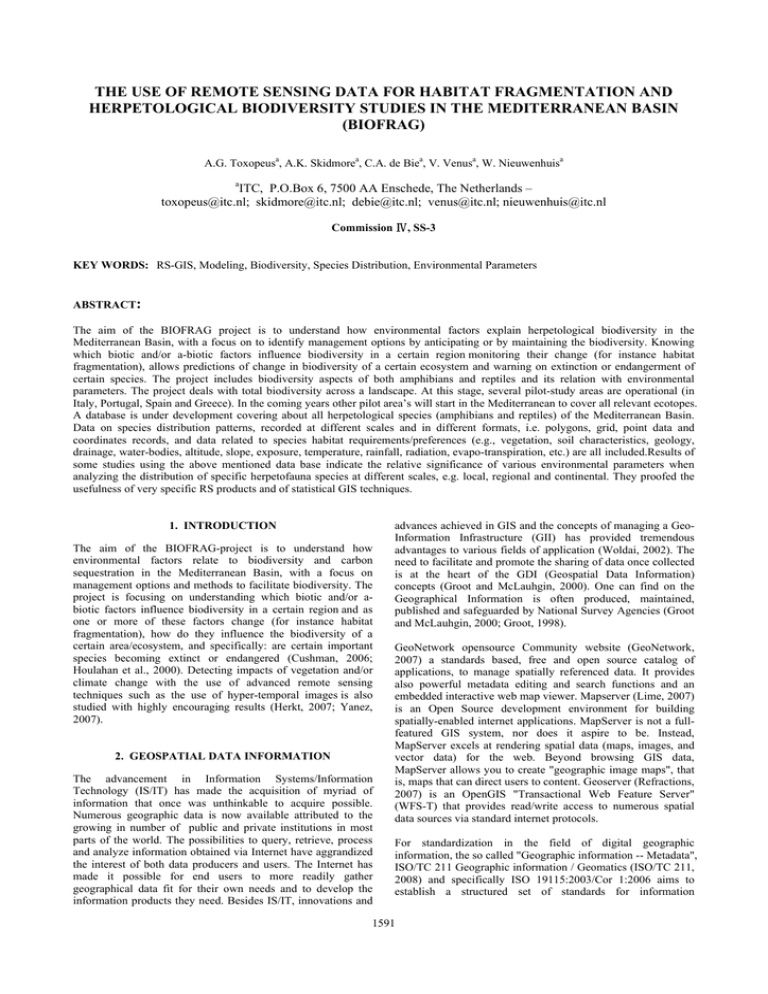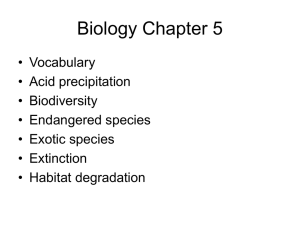THE USE OF REMOTE SENSING DATA FOR HABITAT FRAGMENTATION AND
advertisement

THE USE OF REMOTE SENSING DATA FOR HABITAT FRAGMENTATION AND HERPETOLOGICAL BIODIVERSITY STUDIES IN THE MEDITERRANEAN BASIN (BIOFRAG) A.G. Toxopeusa, A.K. Skidmorea, C.A. de Biea, V. Venusa, W. Nieuwenhuisa a ITC, P.O.Box 6, 7500 AA Enschede, The Netherlands – toxopeus@itc.nl; skidmore@itc.nl; debie@itc.nl; venus@itc.nl; nieuwenhuis@itc.nl Commission Ⅳ, SS-3 KEY WORDS: RS-GIS, Modeling, Biodiversity, Species Distribution, Environmental Parameters ABSTRACT: The aim of the BIOFRAG project is to understand how environmental factors explain herpetological biodiversity in the Mediterranean Basin, with a focus on to identify management options by anticipating or by maintaining the biodiversity. Knowing which biotic and/or a-biotic factors influence biodiversity in a certain region monitoring their change (for instance habitat fragmentation), allows predictions of change in biodiversity of a certain ecosystem and warning on extinction or endangerment of certain species. The project includes biodiversity aspects of both amphibians and reptiles and its relation with environmental parameters. The project deals with total biodiversity across a landscape. At this stage, several pilot-study areas are operational (in Italy, Portugal, Spain and Greece). In the coming years other pilot area’s will start in the Mediterranean to cover all relevant ecotopes. A database is under development covering about all herpetological species (amphibians and reptiles) of the Mediterranean Basin. Data on species distribution patterns, recorded at different scales and in different formats, i.e. polygons, grid, point data and coordinates records, and data related to species habitat requirements/preferences (e.g., vegetation, soil characteristics, geology, drainage, water-bodies, altitude, slope, exposure, temperature, rainfall, radiation, evapo-transpiration, etc.) are all included.Results of some studies using the above mentioned data base indicate the relative significance of various environmental parameters when analyzing the distribution of specific herpetofauna species at different scales, e.g. local, regional and continental. They proofed the usefulness of very specific RS products and of statistical GIS techniques. 1. INTRODUCTION The aim of the BIOFRAG-project is to understand how environmental factors relate to biodiversity and carbon sequestration in the Mediterranean Basin, with a focus on management options and methods to facilitate biodiversity. The project is focusing on understanding which biotic and/or abiotic factors influence biodiversity in a certain region and as one or more of these factors change (for instance habitat fragmentation), how do they influence the biodiversity of a certain area/ecosystem, and specifically: are certain important species becoming extinct or endangered (Cushman, 2006; Houlahan et al., 2000). Detecting impacts of vegetation and/or climate change with the use of advanced remote sensing techniques such as the use of hyper-temporal images is also studied with highly encouraging results (Herkt, 2007; Yanez, 2007). 2. GEOSPATIAL DATA INFORMATION The advancement in Information Systems/Information Technology (IS/IT) has made the acquisition of myriad of information that once was unthinkable to acquire possible. Numerous geographic data is now available attributed to the growing in number of public and private institutions in most parts of the world. The possibilities to query, retrieve, process and analyze information obtained via Internet have aggrandized the interest of both data producers and users. The Internet has made it possible for end users to more readily gather geographical data fit for their own needs and to develop the information products they need. Besides IS/IT, innovations and advances achieved in GIS and the concepts of managing a GeoInformation Infrastructure (GII) has provided tremendous advantages to various fields of application (Woldai, 2002). The need to facilitate and promote the sharing of data once collected is at the heart of the GDI (Geospatial Data Information) concepts (Groot and McLauhgin, 2000). One can find on the Geographical Information is often produced, maintained, published and safeguarded by National Survey Agencies (Groot and McLauhgin, 2000; Groot, 1998). GeoNetwork opensource Community website (GeoNetwork, 2007) a standards based, free and open source catalog of applications, to manage spatially referenced data. It provides also powerful metadata editing and search functions and an embedded interactive web map viewer. Mapserver (Lime, 2007) is an Open Source development environment for building spatially-enabled internet applications. MapServer is not a fullfeatured GIS system, nor does it aspire to be. Instead, MapServer excels at rendering spatial data (maps, images, and vector data) for the web. Beyond browsing GIS data, MapServer allows you to create "geographic image maps", that is, maps that can direct users to content. Geoserver (Refractions, 2007) is an OpenGIS "Transactional Web Feature Server" (WFS-T) that provides read/write access to numerous spatial data sources via standard internet protocols. For standardization in the field of digital geographic information, the so called "Geographic information -- Metadata", ISO/TC 211 Geographic information / Geomatics (ISO/TC 211, 2008) and specifically ISO 19115:2003/Cor 1:2006 aims to establish a structured set of standards for information 1591 The International Archives of the Photogrammetry, Remote Sensing and Spatial Information Sciences. Vol. XXXVII. Part B4. Beijing 2008 concerning objects or phenomena that are directly or indirectly associated with a location relative to the Earth. These standards may specify (for geographic information) methods, tools and services for data management (including definition and description), acquiring, processing, analyzing, accessing, presenting and transferring such data in digital/electronic form between different users, systems and locations. Further information can be found at http://www. unidata.ucar.edu/publications/directorspage/UnidataOverview.h tml. An example of retrieved data from the ITC-IDV server is real time temperature data from Western Europe is given in Figure 2. 2.1 Unidata-IDV (Integrated Data Viewer) Unidata, funded primarily by the National Science Foundation of the U.S (Unidata, 2007), is one of the eight programs in the University Corporation for Atmospheric Research (UCAR) Office of Programs (UOP). UOP units create, conduct and coordinate projects that strengthen education and research in the atmospheric, oceanic and earth sciences (Yoksas, 2007). Unidata is a diverse community of over 160 institutions vested in the common goal of sharing data and tools to access and visualize data. For 20 years Unidata has been providing data, tools and support to enhance Earth-system education and research. In an area of increasing data complexity, accessibility and multidisciplinary integration, Unidata provides a rich set of services and tools and facilitates data discovery and the use of digital libraries. The Integrated Data Viewer (IDV) from Unidata is a Java(TM)based software framework for analyzing and visualizing geoscience data. The IDV brings together the ability to display and work with satellite imagery, gridded data, surface observations, Level II and Level III RADAR data, and NOAA National Profiler Network data, all within a unified interface (Figure 1). Figure 2. An example of retrieved data from the ITC-IDV server: real time temperature data from Western Europe 2.2 BIOFRAG-GDI The Geospatial Data Infrastructure (GDI) routine, under development for the BIOFRAG project, will allow external (internet) users to add information themselves, like species records, maps and/or environmental layers (Figure 3). Figure 3. The window of the ITC’s BIOFRAG-GDI, where the user has to enter the meta-data, before adding data to the geospatial data base It will also allow external (internet) users to view and retrieve data from the ITC-GDI data base. The GDI-routine will make sure the necessary meta-data for each entity will be added and adjusted to the standardized format (Figure 4). Figure 1. Overview of the Distribution Data Environment Server, from where many different sources of geo-spatial data can be queried, retrieved, processed and analyzed 1592 The International Archives of the Photogrammetry, Remote Sensing and Spatial Information Sciences. Vol. XXXVII. Part B4. Beijing 2008 requirements/preferences (Guisan and Zimmerman, 2000) (e.g., vegetation, soil, geology, water-bodies, temperature, evapotranspiration, moisture, altitude, slope, exposure) and environmental parameter layers of bio-physical data (e.g., vegetation, soils, geology, drainage, water-bodies) and climate (e.g., temperature, radiation, rainfall, evapo-transpiration). So far, over 1000 species are recorded in the database and over 3000 species distribution maps are scanned and geo-referenced, of which over 450 distribution maps have been digitized (polygons/grids/points-shape files). Furthermore, thematic maps on climate (rainfall, temperature, radiation, days of frost, evapotranspiration, etc.) and bio-physical items (soil, vegetation, NDVI, altitude, slope, aspect, etc) and many RS images (e.g., SPOT-NDVI, (E)TM, ASTER) are prepared for the Mediterranean Basin (Figure 6). Figure 4. One of the window’s of the ITC’s BIOFRAG-GDI, where the user can retrieve or download geospatial data for own use HERPETO_FRAG research project Species distribution Part I Macro habitat relief A preliminary analysis of the functionalities required for the BIOFRAG geo-database has been carried out and we are now in the phase of the implementation of a prototype system which will enable the researchers involved to access, manage and analyze data from and in a common data structure. The system is built to accommodate unforeseen future data requirements and is positioned as a leading architecture for areas of science e.g., biodiversity conservation science (Figure 5). New RS and GIS techniques cover eco regions mapping and overlay climate rainfall GDI Implementation Architecture Last revision: 14 March 2007 MapIT Data (WFS / WMS ) GetIT Metadata( CSW) Geonetwork Client WFS / WMS Client Data (WFS / Binary ) temperature Internet / Intranet Tomcat Application Server Jetty Application Server species richness GeoNetwork(CSW) GeoServer(WFS) UMMapServer (WMS) Upload servlet Mapping Servlet endemic species correlation model I environmental variables habitat fragmentation PostGIS Database (PostgreSQL) Folder organisation Figure 6. Flow of several activities and links in the BIOFRAG project on macro habitat level to determine the potential habitat and possible habitat change for the different species at Mediterranean scale Page 1 Figure 5. Implementation architecture of the BIOFRAG - GDI 3. DATABASE DEVELOPMENT The BIOFRAG project includes biodiversity aspects on both vertebrates (mammals, birds, amphibians and reptiles) as well as floristics. In other words, the project is dealing with total biodiversity across a landscape at multi scale approach (Grand and Cushman, 2003, Levin, 1992). The project makes use of the findings of a team of PhD- and MSc students, undertaking their research topics in the context of the BIOFRAG project, in one of the selected pilot-study areas. Database development for the more than 1000 herpetological species (Amphibians and Reptiles) around the Mediterranean Basin, includes species distribution patterns, based on distribution extent – level 1 (polygons), grid records – level 2 (observations per hour-grid), observations – level 3 (point data) and observations – level 4 (coordinates records). The data base also includes data related to species habitat The above mentioned thematic maps are prepared at different resolutions and scales, depending amongst others on the requirements of the research topics of the pilot research areas. At this stage, several pilot-research areas are operational. In central Italy (Majella N.P.), in cooperation with the University of Rome, several PhD students started their studies and in other pilot areas MSc students carried out fieldwork and finished their thesis e.g., Portugal (CIBIO), Spain (University of Malaga) and Greece (Natural History Museum of Crete) (Figure 7). Other pilot-study areas are hopefully being developed in France, North Africa and W Asia (with Iran ITC has established contacts through 5 years participation in the JIK program and through existing PhD scholars). It is in the planning for the coming 5 years to upscale the pilot areas to the entire Mediterranean, and fill in gaps with additional biodiversity information from known sources. Furthermore, the BIOFRAG project has successfully networked with other institutes and/or universities in the above mentioned region. Joint research 1593 The International Archives of the Photogrammetry, Remote Sensing and Spatial Information Sciences. Vol. XXXVII. Part B4. Beijing 2008 proposals to raise more funds for the project to be able to invest more in fellowships, fieldwork and equipment are submitted. 5. CONCLUSIONS The BIOFRAG project aims to offer users spatial data on species and environment and to support and accommodate research. In this context under the BIOFRAG project research is supported through PhD fellowships and Post-Doc positions or through MSc research topics and Internships. HERPETO_FRAG research project Part II pilot studies species REFERENCES richness distribution New RS and GIS techniques Cushman, S.A., 2006. Effects of habitat loss and fragmentation on Amphibians: A review and prospectus. Biological Conservation, 128(2), pp. 231-240. micro habitat GeoNetwork, 2007. GeoNetwork opensource Community website. http://geonetwork–opensource .org/ (accessed 22 Sep. 2007) density species richness endemic species interpolation correlation model II verification environmental variables Grand, J. and Cushman, S.A., 2003. A multi-scale analysis of species-habitat relationships: breeding birds in a pitch-scrub oak (Pinus eigida-Quercus ilicifolia) community. Biological Conservation, 112(3), pp. 307-317. habitat fragmentation extrapolation correlation model I Groot, R. and McLaughin, J., (eds.), 2000. Geospatial Data Infrastructure: Concepts, cases and good practice. Oxford University Press. Figure 7. Flow of several activities (pilot research areas) and links in the BIOFRAG project on micro habitat level to determine the potential habitat and possible habitat change for the different species at different scales Groot, R., 1998. The role of national mapping agencies in the development of National Spatial Data Infrastructure. In: Proceedings in International Conf. of spatial information Science and technology, 2000, Wuhan. 4. RESEARCH OUTPUT Although the BIOFRAG project involves also research in regions outside the Mediterranean Basin, a summary is given for some research output on herpeto-faunistic topics for the Mediterranean only: • Multi-Scale assessment of the potential distribution of two herpeto-faunal species: Bombina variegatae and Vipera ursinii showed, that at regional scale climatic parameters were the most important predictor parameters, while at local scale biophysical parameters became more important (e.g., distance to streams for Bombina variegatae, land cover for Vipera ursinii) (Marquez, 2006). • Modelling habitat suitability to predict the potential distribution of Erhard’s wall lizard Podarcis erhardii on Crete demonstrated the significant importance of the use of multitemporal NDVI as predictor variable (Herkt, 2007). • A study on the influence of human activities on the distribution of amphibians and reptiles in the Salamanca province, Spain, indicated, that especially for amphibians that influence can be quite positive (Sun, 2007). • A study on marine turtles nesting habitats of Caretta caterra in the Mediterranean revealed that although many beachlocations seems to be suitable, especially along the southeastern coastline, occurrence of nesting has not been documented. It looks like years of uncontrolled exploitation might have contributed to the loss of the nesting rookeries, hence lack of occurrence records (Moin, 2007). • The thermoregulation and the use of microhabitat by Timon lepidus has been studied by recording ambient temperature, solar radiation, wind speed and relative humidity every minute, while the surface and lizard skin temperature were recorded by a thermal camera. The incident solar radiation and air temperature have much more influence on the body temperature than surface temperature ( Yanez, 2007). Guisan, A. and Zimmerman, N.E., 2000. Predictive habitat distribution models in ecology. Ecological Modelling, 135(2-3): pp. 147-186. Herkt, M., 2007. Modeling habitat suitability to predict the potential distribution of Erhard’s wall lizard Podarcis erhardii on Crete. GEM-serialno: 2005-15. 80p. Houlahan, J.E., Findlay, C.S., Schmidt, B.R., Meyer, A.H. and Kuzmin, S.L., 2000. Quantitative evidence for global amphibian population declines. Nature, 4004(6779), pp. 752-755. ISO/IT 211, 2008. ISO/TC 211 Geographic information/Geomatics, Norwegian Maping Authority. http://www.isotc211.org (accessed 3 Feb. 2007) Levin, S.A., 1992. The problem of pattern and scale in ecology. Ecology, 73, pp. 1943-1967. Lime, S., 2007. Mapserver. University of Minnesota (UMN) ForNet project. http://mapserver.gis.umn.edu/ (accessed 14 Oct. 2007) Marquez, J.R.G, 2006. .Multi-Scale assessment of the potential distribution of two herpeto-faunal species: Bombina variegatae and Vipera ursinii. ITC-publication. 48 p. Moin, N., 2007. Modeling critical coastal ecosystems: a study on the marine turtles nesting habitats in the Mediterranean. GEM-serialno:2005-24. 78pp. Refractions, 2007. GeoServer, Refractions Research Victoria, Brittisch Colubia. http://refractions.net/ (accessed 12 Jan 2008) 1594 The International Archives of the Photogrammetry, Remote Sensing and Spatial Information Sciences. Vol. XXXVII. Part B4. Beijing 2008 Sun, Y., 2007. Influence of human activities on the distribution of amphibians and reptiles in the Salamanca Province, Spain. GEM-serialno: 2005-07. 54 p. Unidata, 2007. http://www.unidata.ucar.edu/ directorspage/ UnidataOverview.html publications/ Woldai, T., 2002. Geospatial Data Infrastructure: The problem of developing metadata for geoinformation in Africa. In: Proceedings in 4th AARSE Conference on geoinformation for sustainable development in Africa. October 14-18 2002 Abuja, Nigeria. Yanez, F.F., 2007. Thermoregulation and use of microhabitat by Timon Lepidus (Daudin, 1802). ITC-publication. 55p Yoksas, T., 2007. Unidata. Office of Programs, UCAR. http://www.unidata.ucar.edu/ 1595 The International Archives of the Photogrammetry, Remote Sensing and Spatial Information Sciences. Vol. XXXVII. Part B4. Beijing 2008 1596








